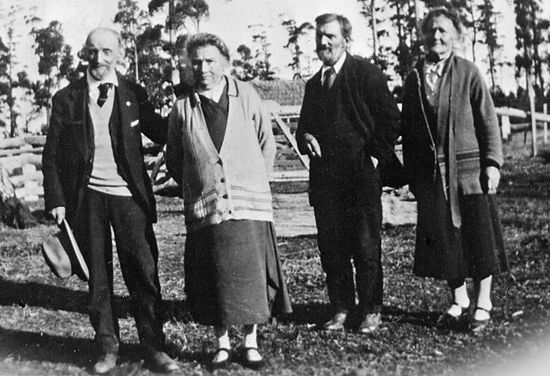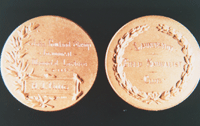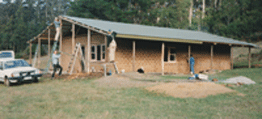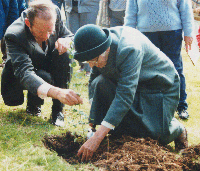
HISTORY OF THE SKEMP PROPERTY
MYRTLE BANK
Introduction
This history really began in 1862 and 1863 when Samuel and Rowland Skemp were born in Shropshire, the youngest sons of a Baptist Minister, the Reverend Thomas Skemp. There were four older boys and a girl and they were orphaned when the young boys were still at school and in their teens. They had a strict religious upbringing and were not allowed to play any games even marbles. The only indoor amusements allowed were draughts and chess. Alcohol was forbidden but tobacco wasn’t so both boys took to the pipe. They were great walkers and often covered sixteen to twenty miles in an afternoon.
The house had a well stocked library and both had read all of Shakespeare, Dickens and Scott before they left school. Samuel’s ability to pass exams marked him for the reasonable profession of a teacher. He soon discovered that he was not cut out for a school career and like many other young men at the time saw his future in the colonies. He supplemented his teachers pay by coaching and in a couple of years had saved between thirty and forty pounds enough to book a passage on the clipper ‘Cassiope’.
1882 - 1886
He sailed for Australia in May 1882 arriving in Melbourne in August and stayed at the Victoria Coffee Palace for four shillings a day all found. He had intended to go to New Zealand but men returning from there reported a lack of work so he decided to go to Tasmania as there appeared to be plenty of work available.
After a short time in Melbourne he sailed for Launceston on the S.S. Flinders. Launceston then had 12,000 inhabitants and Elphin Road passed through dairy farms. The Cataract bridge had just been built but no-one lived on Trevallyn. A brother had given him an introduction to a Frank Chester who was setting up as an itinerant photographer. Sam joined him and they worked in the North-West. Sam saw land being developed and decided that this was man’s work and he wanted to be part of it. He went to work as a farmhand for Henry Rockcliffe at Sassafras.
Rowland’s artistic ability and the influence of his older brothers enabled him to obtain an apprenticeship as a calico designer for one of the mills at Manchester. He was fifteen years old and was extremely interested in music, literature and debating. He continued his music studies and got out into the countryside with his sketchbook at every opportunity. Darwin’s hypothesis on the origin of the species was causing a controversy and he sided with Darwin. He attended lectures by an atheist and became an agnostic which probably shocked his older brothers. From childhood he had been delicate, small and frail of build and the murk and grime of Manchester and the strenuous life he led saw him picked up unconscious in the streets and he woke up in the Manchester infirmary. He was told to get out of town and lead an open air life if he wanted to live. His brothers agreed and joining Sam in the colonies seemed the obvious choice. He sailed for Australia on the S.S. Potosi in 1883.
Meanwhile Sam had left Sassafras and at a Crown Land auction had purchased, sight unseen, a block of 20 acres at Myrtle Bank for twenty pounds. However he knew that it was near Launceston and that there was a patch of chocolate soil there. When Rowland arrived he and Sam set out on foot for the Myrtle Bank block, the cost of travel being beyond their means. They took refreshments at the several hotels on the way and stayed overnight at Faulkner’s Hotel at Myrtle Bank. They were conducted to the block next day by William Faulkner and found that except for a small clearing in the middle it was dense virgin bush. There was a small one-roomed hut in the clearing that had been constructed by a paling splitter named Boden who had let the block go when he had cleared out all trees suitable for splitting. The hut was well built from local timbers, all split by Boden. The fireplace was constructed of sandstone from the hill to the south. They found that their block was just off the edge of the basalt and was mixed slate and sandstone which was probably another reason why Boden stopped making instalments to the Crown. The brothers travelled East endeavouring to find a suitable block on basalt but they were hard to find and as well, the Government had suspended land sales pending survey for a railway line. They settled at Myrtle Bank.
Rowland’s health had improved on the voyage and through his open air wandering with Sam. Sam’s skill at clearing guided Rowland and once the farm was established, Sam often took other jobs such as tin mining and paling splitting to supplement the farm income. They walked the twenty-five miles to town every three months and purchased books as well as food supplies. The round trip took them ten hours and if they left by five o’clock in the morning they could be back the same day. Papers regularly arrived from England right up to the time of John Skemp’s death. For recreation they played chess and Rowland did water colour and pencil sketches. After a year or two they built a 24 feet x 16 feet two-room dwelling made from split palings and with a slab floor. Most of the neighbours were poorly educated and some of convict stock, so that the brothers had little in common with them. The locals thought that as the Skemps were obviously well-educated they must be remittance men. back to top
1886 - 1900
At the beginning of 1886 a state school was opened at Patersonia and a
Miss Florence Kearney, a young lady from Richmond district, was put in charge of it at a salary of forty pounds a year.
Rowland met Miss Kearney at a picnic on Hart’s property on the St Patrick’s River where a patch of virgin myrtle forest had been cleared and oaks and hazel-nuts planted. This is now a public recreation ground called ‘Myrtle Park’. Neither of the two carried away a very favourable opinion of the other. She thought him a bit too clever and satirical and he, although a professed agnostic, thought she must be a Roman Catholic. Early Puritan training had given him a deeply ingrained mistrust of them. However she followed the Church of England and was most tolerant of other religions. As they met at various functions over the years, their admiration for each other grew so that in 1893 Rowland in spite of his lack of material wealth, cautiously made his feelings known to Florence and she responded in kind and they became engaged.
As the two-roomed dwelling was going to be inadequate, Sam and Rowland constructed another two-roomed building at right angles to the first and connected them by a verandah. Later two bedrooms were built skillion fashion against the new section. Then the original building was changed internally and had a spare bedroom and kitchen built against it. Front and back verandahs sheltered the weather sides. Rowland and Florence were married at Richmond on February 28 1894. At the end of the year Florence went back to the family home to await the birth of a child. It was still-born and when Rowland was notified late in the day, he saddled the horse and rode off south. The horse gave up at Ross, 70 miles down the track later that night. Rowland heard that a train was leaving from Parattah at 6 am next morning. He immediately set out on foot covering 20 miles by five in the morning. He caught the train and arrived at Campania at 8 a.m. When next year an unwanted baby boy appeared amongst the southern relatives, he was soon installed at Myrtle Bank. Les never knew any other parents or wanted better.
Around this time a brother, the Reverend Thomas Skemp, visited them. He had had several novels published, one of then called ‘Reediford Holm’. Florence liked the name and the Myrtle Bank property was so named. back to top
1900 - 1949
John Rowland Skemp was born at the Queen Victoria Hospital, Launceston on July 2 1900. In 1901 the teacher in charge of the Myrtle Park School, Miss Violet Carins was promoted to Longford and Florence Skemp was able to overcome the objections of the Education Department to employing a married woman and once again resumed teaching which continued for the next 30 years. The family domestic ties which bound Florence's sister, Ada, to the family home no longer held and she moved to Myrtle Bank to keep house for the Skemps. Many people, relatives, friends and locals visited 'Reediford Holm' over the years and were always assured of a welcome and accommodation. Rowland had a guitar and now acquired a Canadian organ and with Sam (self taught) on the violin, musical evenings were regularly held at the home. Singing classes were also held and a concert given annually. Rowland also played the organ at the Patersonia Church.

The fruit of the orchard was always freely available to locals, a practice which they assume to this day. Jack Skemp excelled at school and soon caught up to ‘brother’ Les who excelled at things mechanical but not scholastic. Unfortunately there were no technical schools where Les may have developed his natural ability with tools. Les later moved to New Zealand. His son, Rowland Skemp, still lives there.
In 1913 the State Education Department opened its first secondary high school. Jack passed the qualifying exam and in 1914 enrolled at the Launceston State High School which occupied three rooms at the Charles Street Primary School. After four years Jack won a scholarship to the University of Tasmania and for the next three years studied Engineering and Science. He left University at the end of 1920 not knowing what to do and still needing the subject ‘Surveying’ to complete his degree. By default he became a teacher but, as he refused to sign a bond, was employed thereafter in a temporary capacity. Jack spent all of 1923 working for a surveyor trailing a chain line, cutting lines and blazing trees in order to complete his degree. It was an exceptionally wet year and he was glad to see the end of camping out and being almost continually wet.
He sailed for England in 1924 with some University friends and returned the same year. Myrtle Bank was suffering an invasion of rabbits and the farm was not profitable so he decided to help on the farm and play lots of cricket. After the installation of many wire netting fences and Jack’s help, the farm once again became viable. Jack took on the position of secretary to the local branch of the Agricultural Show Society of which his father, Rowland, was president. Rowland, by now was a Justice of the Peace, a St. Leonard’s councillor - later warden, and unable to give much of his time to the farm. His mother, Florence, died in 1934 and her sister, Ada, who had looked after the household so well, died in 1939. The same year, Jack went back to teaching nature study to Northern Schools. He was based at the Queen Victoria Museum and travelled to schools making frequent use of the museum specimens and the wonderful natural history films made by H.J.King, a close friend.
During 1945 Rowland’s health deteriorated and Jack was granted twelve month’s leave of absence. His father died at 84 years of age. At the end of twelve months Jack returned to the Museum. His uncle, Sam, lived on for two more years.
back to top
1949 - 1987
In 1949 the Launceston Field Naturalists Club began and Jack Skemp was made Vice President. In 1959 he was made a life member having contributed much to the successful running of the Club and giving many interesting lectures during this time. In 1952 he wrote ‘Memories of Myrtle Bank’, the story of his family and many of the settlers of the area. It raised quite a stir locally. When his Aunt Ada died, she left a box of correspondence that had belonged to her mother, Anne Kearney (Lovell). From these he wrote ‘Letters to Anne’ in 1956. A book Jack wrote in 1959 became a school textbook, this was ‘Tasmania Today and Yesterday’. In 1961 together with his friend, Tom Burns, also an active member of the Launceston Field Naturalists Club, ‘Van Diemen’s Land Correspondents’ was written from the letters of early botanical collectors, mainly Robert Campbell Gunn. During the weeks before his death from cancer in 1966, Jack conceived a book which gathered together some of his bird essays and this was published posthumously by Tom Burns. It was titled ‘My Birds’. In his will Jack suggested that the texts of his many ABC talks could be put together and published but this has not been done.
In 1967 Tom Burns instituted a ‘John Skemp Memorial Lecture’ and asked H.J.King to present the lecture. Tom also arranged and paid for a suitable medallion. It was a wonderful lecture and as a result, the Club has carried on the tradition to this day.
 |
| John Skemp Memorial Lecture Medallion |
The Myrtle Bank property was willed to the Launceston Field Naturalists Club and the transfer was finalised in 1968. John Gee had arranged a land swap with a neighbour so that the Club gained a gully with a waterfall and the neighbour gained cleared land. John Gee as convenor of the Skemp Property Committee arranged to dispose of the dwelling as suggested in the will. Unfortunately, for some reason, the Club was not privy to the will and the understanding was that the house had to be totally destroyed. When in 1971 Tom Burns provided a copy of the will, it was realised that the Club was meant to retain any useful materials should it decide to build on the land.
When the time came to dismantle and burn the building, it was found that opportunists had moved in and removed everything of any possible use from the roof down. Even the galvanised water pipe that provided the water supply from a spring up the hill had disappeared. The water pipe terminated over a concrete tub near the house and water was collected from it. The tub now sits just above a corner of the Field Centre. Ray Cameron retained a small hand-made window which we intend to use on a suitable project. He also retained a huon pine coathanger that Jack Skemp had made at the Sloyd Woodwork School in Launceston. It is now near the back door of the Field Centre and if you look carefully you can see the Sloyd stamp with a mark of ‘9’. A similar model near the front door was made by a relative of one of the members.
During preparation for burning the house, an old chair was found which was padded with very old newspapers bearing English stamps and these were rescued and are now in our library cupboard. The only other article saved is an old mallet made from bush materials and this too is stored in the building. The bricks from around the old copper in the laundry have been used in the construction of the barbecue. back to top
1987 - 1998
At the time the Club was in no financial position to build on the property, so it was suggested by a member that a book on Tasmanian wildflowers be written in order to make sufficient money for the building. The money received was well invested by our then treasurer, Terence Butler and by 1987 when the foundation was laid, the sum had grown to $25,000. Neville Gray had drawn up the plans for the Club building.
Water was needed for the building operation and a polythene pipeline, which came from a spring at the top of our property, was found within 25 metres of the building site. It goes to the farm of our neighbour, ‘Brum’ Imlach who incidentally, was a pupil of Florence Skemp. It was possible to tee off the line and provide good water for the building operations and the Centre today. The line was installed about 40 years ago and occasionally blocks. ‘Brum’ used to walk the water line to find and clear the blockages, but one day discovered a new barbed wire fence blocking his way (we had fenced out the sheep from the building area). A gate was put in the fence for him and named ‘Brum’s Watergate’ - much to his delight.
The concreting contractors laid the foundations 90 degrees out of line and as compensation poured an extension which gave us two verandahs one of which has now been converted to a store and two bedrooms. Mud bricks were made locally and laid for a reasonable fee by Rob Larner who had been a member of our junior club. He was assisted by Harry Gardner who mixed the mortar in his own petrol-driven mixer and became known as ‘More Mud Harry’! Jeff Campbell spent a tremendous amount of time and energy on the building and excavated the hole for the septic tank in almost solid slate, using a hammer and cold chisel, together with fire and water. Ivan Ebdon’s expertise as a builder has been a great advantage to the Club. Bill Stephens, Geoff Martin and other present day members have helped immeasurably at different times. John Simmons has expended a tremendous amount of time and energy on the building and improvements, doing most of the planning and ordering as well as being involved in most of the implementation.
.gif) |
 |
| Brick laying in 1987 | Roof in place June 1988 |
Most club members have given time, money and effort to the building. Fairs, garage sales, market days and raffles have been a big help with finances.
 |
Dr Winifred Curtis planting commemorative tree assisted by Jeff Campbell |
The building was officially opened by our Patron, Dr Winifred Curtis, on May 6th 1989. A commemorative tree, Eucalyptus urnigera, was planted by Dr Curtis to mark the occasion. A plaque, to mark the occasion, was unveiled on 5th December 1998.
back to John Skemp Field Centre
General and Technical Feedback | Last update 10 March 2008
Copyright © Launceston Field Naturalists Club | Website design by Karen Manning